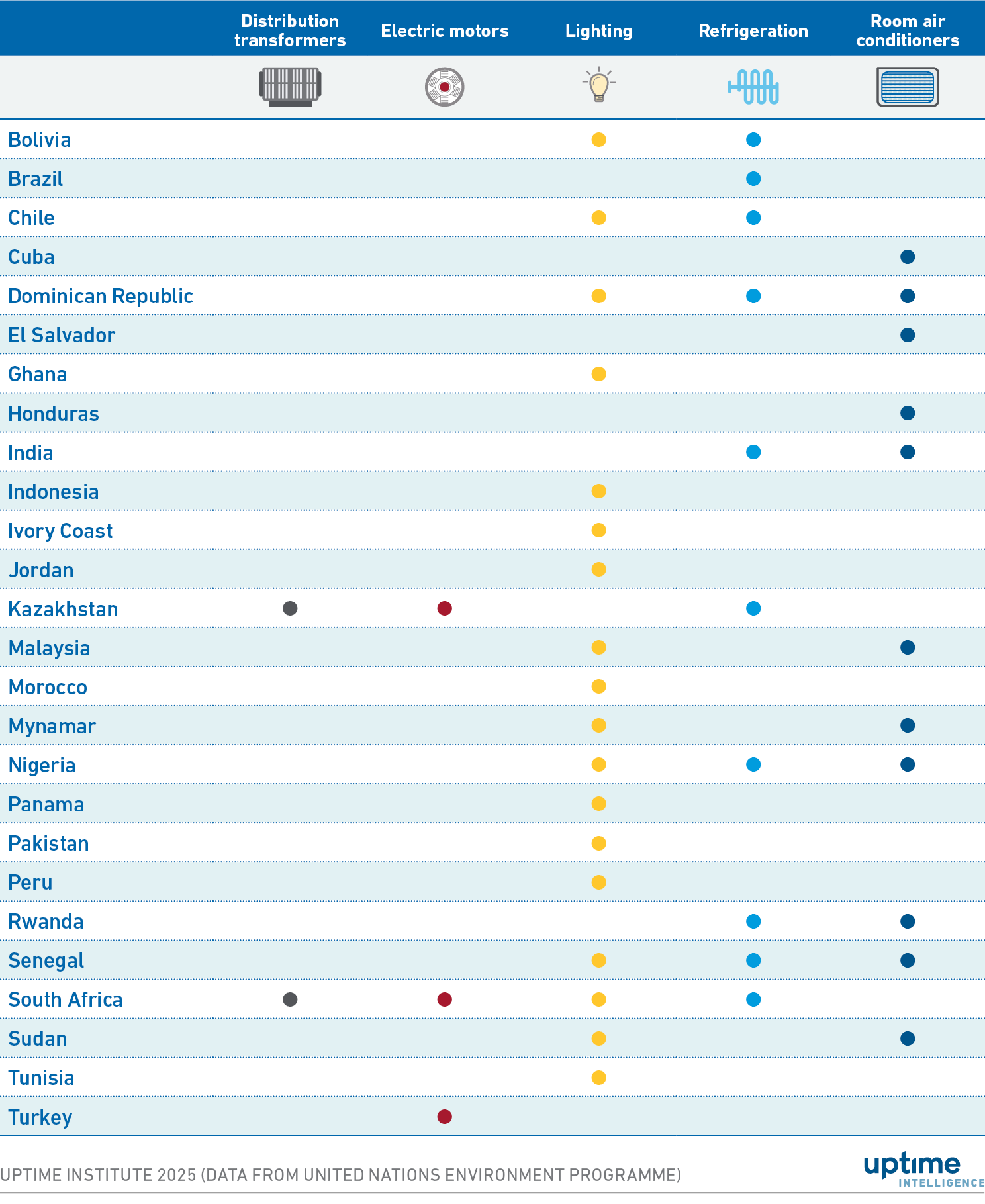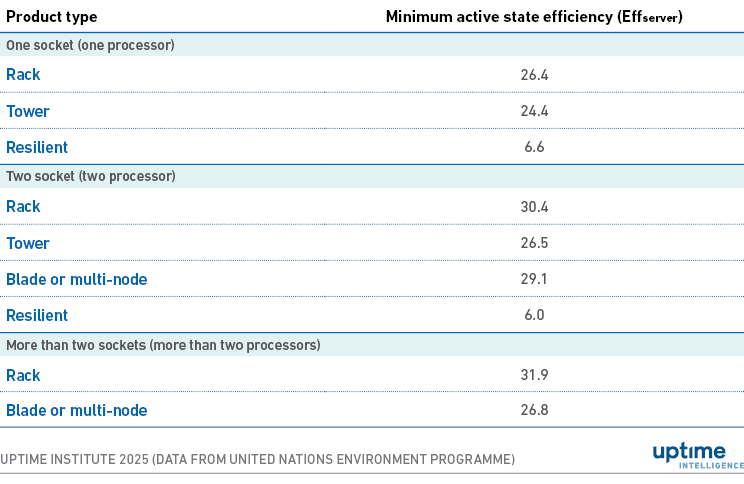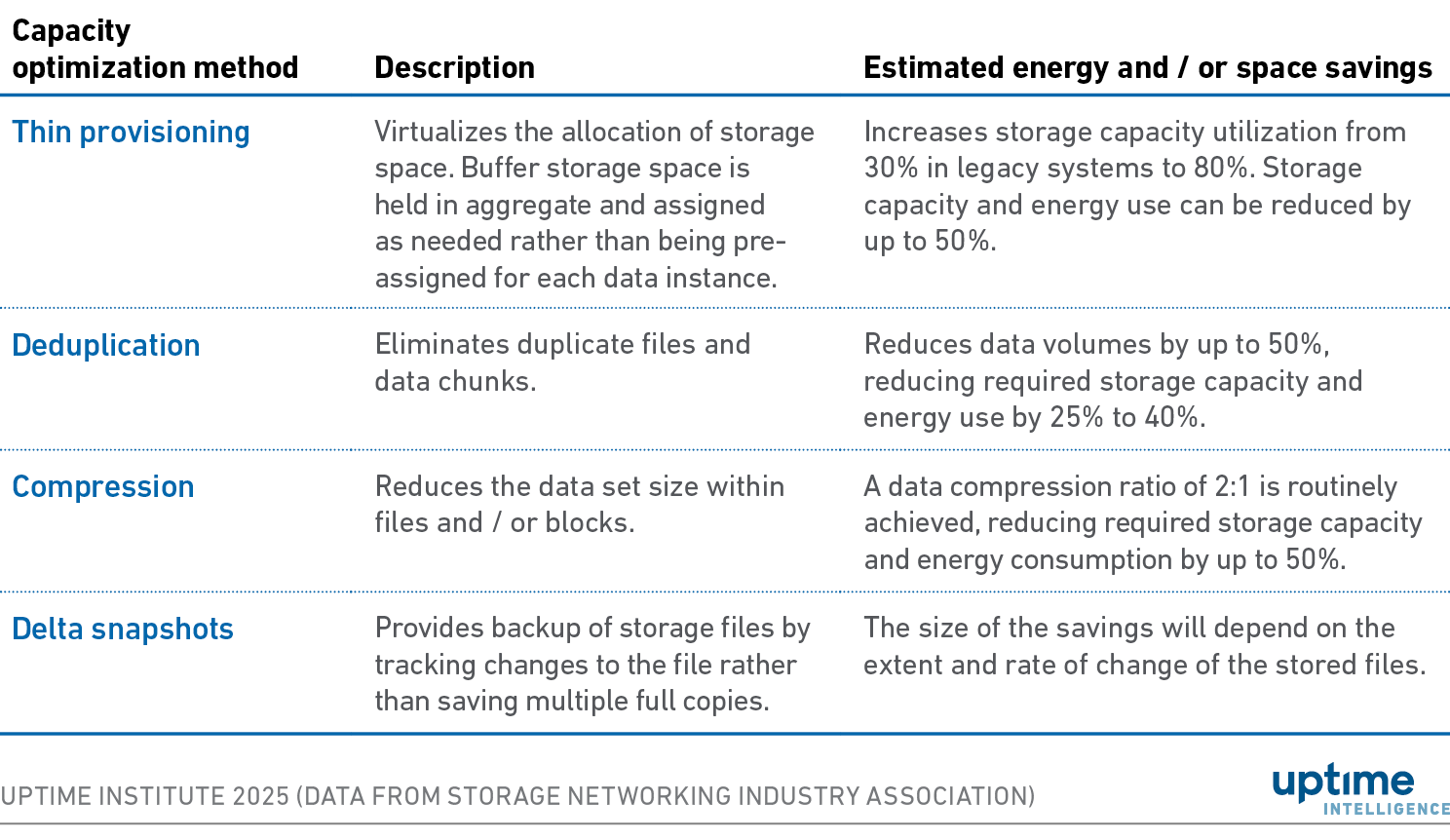UII UPDATE 322 | JANUARY 2025
Intelligence Update
UNEP specs for IT efficiency: more work required
United for Efficiency (U4E), a global policy initiative led by the United Nations Environment Programme (UNEP) to promote energy-efficient products, has proposed guidance for data center equipment and IT systems. The Green Public Procurement Technical Guidelines and Specifications for Energy Efficient Data Centers and Servers (hereafter referred to as the Guidelines) specify operating requirements and performance thresholds for IT and facility infrastructure, as well as procurement and performance requirements for server and storage equipment. UNEP U4E's influence spans South America, Africa, the Middle East, and Asia-Pacific geographies (Table 1).
Table 1 UNEP’S United for Efficiency projects: regions and countries

A previous Uptime Intelligence report covered the 14 data center technical specification subcategories that detailed operating requirements and minimum performance thresholds for metrics such as PUE, water usage effectiveness (WUE), IT equipment utilization, renewable energy factor (REF) and energy reuse factor (ERF) that define an energy efficient data center (see UN body’s data center guidelines cause concern).
This update will address the 10 server and storage product efficiency subcategories. These subcategories cover the active state efficiency of server and storage products, power management, and idle power for server products, the minimum IT equipment ASHRAE classification, and conditions for equipment serviceability and management of electronic waste.
Uptime Institute (and others) have provided comments and feedback on the Guidelines to U4E, encouraging UNEP to make reasonable changes.
UNEP used existing standards and their minimum performance levels to set the product specifications for server and storage products. Networking products are not included since they typically represent just 3% to 5% of data center energy consumption, and there are no comparable standards to reference.
Server and storage products
The four server and storage product specifications make use of the Energy Star server (V4.0) and storage (V2.0) standards for the active efficiency requirements (Tables 2 and 3). The server efficiency ratings are composites of the weighted energy efficiency of compute and storage systems, based on the Server Efficiency Rating Tool (SERT) database. The storage product ratings are built on the efficiency data generated by the Storage Networking Industry Association (SNIA) Emerald Power Efficiency Measurement Specification. The idle power limit for server products (Table 4) and the power supply efficiency and power factor minimum performance requirements (Table 5) are in line with the EU’s server and data storage product ecodesign regulation (EU 2019/424).
Table 2 Minimum active state efficiency of servers

Table 3 Active state efficiency for block input/output storage products

Table 4 Idle state power allowances

Table 5 Minimum power supply unit efficiency

Uptime recommendation
For all four specifications (detailed in Tables 2 to 5), Uptime recommended that UNEP directly reference the standard or regulatory sections that set the efficiency requirements. The recommended sections will cover included and excluded products and the measurement and testing requirements.
For storage products, the specification should require that 80% of purchased storage systems should include at least one applicable capacity optimization method (COMs), also known as storage efficiency technologies. Table 6 describes the four major COMs. COMs increase the density and quantity of the data storage on the individual drives, enabling more data to be stored on less equipment with lower energy consumption and occupied space.
Table 6 Capacity optimization methods

- Server idle limits. The proposed Guidelines have misapplied the idle power limits by omitting the idle allowance for CPU core count and installed storage devices. This oversight will disqualify many servers with higher core count CPUs, such as Intel Gold and Platinum CPUs and AMD EPYC CPUs that have 32 or more cores. For the best outcome, Uptime recommended that UNEP remove the idle limit requirements because the combination of the minimum performance threshold for the active efficiency value and the requirement to deploy power management as appropriate will drive lower idle power consumption. Energy Star V4.0 has taken this approach. If UNEP chooses to retain the idle power limits, they should include the full range of idle allowances specified in the EU 2019/424 regulation.
- Power supplies. The specification should set power supply efficiency and power factor requirements for power supplies with capacities of 750 W or less and more than 750 W, similarly to the Energy Star 4.1 specifications for server products. Smaller power supplies have slightly lower efficiency values at the 10%, 20%, 50%, and 100% measurement points, but they offer greater overall efficiency when the power supply is right-sized with the power demand of the server or storage product configuration.
IT equipment operating temperature
The Guidelines specification requires procuring IT equipment rated for operation at ASHRAE Class A3 or A4 temperature and humidity ranges. Specifying that IT equipment be rated as A3 or above, as opposed to A2, increases the allowable maximum temperature range (the temperature above the recommended maximum operating temperature of 27°C that will limit additional equipment failures) from 35°C for an A2 classed product to 40°C for an A3 classed product. The A3 designation increases the available free cooling time by 1% to 10% depending on the data center's external climatic conditions, reducing cooling energy requirements.
A3-compliant designs may require a larger rack slot (e.g., 1.5U or 2U, instead of 1U) for each server, limits on the CPU's core count and power demand, and/or higher fan speeds to ensure server reliability at the higher allowable temperature. These thermal design limitations go against infrastructure energy performance and can result in higher power consumption in the data center due to higher fan speeds and the need for more, lower core count CPU servers to meet the same workload requirements.
Uptime recommendation
The Guidelines should specify a minimum A2 classed product to broaden the available product configurations and enable data center operators to optimize product configurations and facility system control settings to minimize overall energy consumption and optimize performance.
Server energy efficiency
This specification requires a new server to have a higher ratio of maximum work capacity to maximum power demand compared to the server that it is replacing, as well as a higher average maximum work capacity to maximum power demand ratio compared with a group of servers in the data center. The requirement will be challenging to implement because it does not specify the value to be used to calculate server work capacity or a definition of the comparative group of servers.
IT operators refresh existing servers with servers with a n+1 to n+x generation CPU (where n equals the CPU generation used in the currently installed server) depending on the age of the server to be replaced. A higher technology-generation CPU will have a higher work-per-watt ratio than a lower technology-generation CPU with a comparable core count.
Uptime recommendation
UNEP should modify the server refresh requirements to remove at least two existing servers for each new server. This replacement ratio should be applicable for at least 80% of the existing servers designated to be refreshed. The replacement ratio should be higher when the new server has an n+2 or greater technology generation. Specifying a minimum replacement ratio will improve the work delivered per megawatt-hours of energy consumed, without requiring reference to a difficult-to-calculate metric. The “at least 80%” criteria for the 2-to-1 replacement provides the required flexibility to accommodate unique upgrade scenarios that cannot conform to the 2-to-1 consolidation rate.
Power management
The Guidelines require that servers can deploy CPU power management functions. These functions are almost universally available on current server products. Uptime has published a range of reports detailing the benefits of deploying power management functions and the internal processes needed to identify workloads that can tolerate the associated increased latency and response times. The Uptime Institute Data Center IT and Power Efficiency Survey 2024 found that 52% of respondents (n=264) had a policy to use power management functions where it was practical. Of these respondents, 64% reported deploying power management functions to 50% or more of their server infrastructure.
Serviceability and waste management
These two specifications are based on requirements laid down in the EU 2019/424 regulation. They focus on design for non-destructive repair, easy equipment disassembly, spare part reuse/recovery, and end-of-life disposal.
Observations
The UNEP U4E proposal for server and storage product technical specification has several shortcomings. It fails to fully cite the definitions and implementation details of the relevant EU regulation (EU 2019/424) and Energy Star standards; omits a requirement for storage products to offer storage capacity optimization methods; and creates a confusing and difficult-to-implement refreshed server capacity improvement methodology.
As a result of these omissions and incomplete descriptions of calculation methodologies, the Guidelines may unintentionally exclude many efficient products in countries that decide to adopt these Guidelines as regulations of procurement standards.
Data center and IT infrastructure operators with current or planned facilities in the countries targeted by the UNEP U4E Guidelines should monitor regulatory developments closely. They should also take advantage of open comment periods to express their views and address any inadequacies relating to the proposed Guidelines and national (or regional) regulations.
The Uptime Intelligence View
Government legislators and regulators are taking steps to address the growing energy demand of data centers by establishing mandatory guidelines and performance thresholds. Because of the complexity of the data center infrastructure and the lack of understanding of the impact of current regulations and standards, these efforts risk creating a complex web of requirements that are as likely to limit as to improve the efficiency of data center operations.
Data center operators need to be more open and forthcoming about operating metric values and the performance of their facility and IT infrastructure. Actual operating data and information provides a stronger foundation for developing and implementing data center information reporting and performance thresholds mandates.
Note: The regulatory analysis provided in this Update is the opinion of Uptime Intelligence. Data center operators should validate the interpretations with their legal staff and any relevant regulatory authorities.

